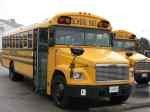 For some children, a new school year is an exciting time to make new friends and learn new things. For others, including those with disabilities, a new school year can be a challenge. Some children worry how others will react to them. Those with not so obvious learning disabilities or attention disorders sometimes worry they won’t appear smart. Students with Autism or Anxiety disorders can struggle with new routines and the unknown, which can cause back to school panic as well. And of course, those of us that are parents of a child with a disability can’t help but worry about our children worrying! Fear not, though. There are things you can do to ease these back to school nerves.
For some children, a new school year is an exciting time to make new friends and learn new things. For others, including those with disabilities, a new school year can be a challenge. Some children worry how others will react to them. Those with not so obvious learning disabilities or attention disorders sometimes worry they won’t appear smart. Students with Autism or Anxiety disorders can struggle with new routines and the unknown, which can cause back to school panic as well. And of course, those of us that are parents of a child with a disability can’t help but worry about our children worrying! Fear not, though. There are things you can do to ease these back to school nerves.
Author and education expert Laura Riffel, PhD. has thirty years of experience working with teachers and parents of children with special needs. She says to focus on three things: routines, space, and organization.
Routines:
Some children need more time with transitions than others, so it might be wise to keep a routine all summer. For others, beginning the routine a few weeks before school starts will work.
Start the bedtime routine earlier by a few minutes each day so the desired school-night bedtime is reached at least a week before the first day of school. In the morning, have your child use an alarm clock and have them get dressed and ready for the day.
A Study Area:
Even if your child will not be having homework, setting up a study area will encourage good habits for reading, writing or quiet time.
If possible, try to create different areas for each child. This way there is no fighting over space or supplies. Also, think of the needs of your child, whether it’s a specially designed chair, extra lighting, muted lighting or soft color tones. For some children, having pictures of appropriate activities will help them remember what the space is for. A calendar with due dates or important activities will also benefit your child, and in the beginning of the school year, help them use it.
Organization:
As the school year starts, there will be lots of paperwork and supplies to keep on top of. Having a system will help everybody stay organized, which will help for a stress-free school day. Whether it’s packed bags the night before or a crate for supplies, mornings will definitely go smoother if this is accomplished.
Introducing new teachers
Teachers are happy to meet with you, however their time is spent in meetings and workshops, as well as cleaning and organizing. Calling ahead to schedule an appointment will guarantee you the best possibility of connecting with the teacher.
Consider your goal for meeting with teacher ahead of time. If the purpose of the visit is to assist your child in understanding who they will be working with throughout the year, bring them along. If there are concerns with wheelchair or mobility issues, it will help both the teacher and the student to make sure the classroom is prepared with wide aisles and supplies at appropriate levels.
In my son’s case, I called his teachers ahead of time to schedule a time for Drew and me to visit. While some teachers are trained to assist students with Autism, most teachers know nothing about Verbal Apraxia, a disability that impairs his ability to create purposeful speech movements. So while his anxiety about new chaotic situations was understandable, his inability to communicate was more confusing. We brought in some coffee cake to the school one morning to meet his teachers and show him his classroom, where he would hang his backpack and see what materials he would be using. We kept this meeting short, but it served its purpose.
Many websites that offer support for parents of children with various disabilities provide resources specifically for parents to give to the teacher that explains the disability. In my case, www.apraxia-kids.org had great resources I would occasionally print off and bring for his teachers. It helped them understand his needs.
Starting a new building
If your child is starting in a new building, one of the best strategies for success, according to Dr. Riffel, is to take the child through the school day in its entirety. Bring along a camera to take pictures of the classrooms and staff that might work with your child. In the days leading up to school, review the photos and talk about what will happen, and who your child will meet.
As with most things, planning ahead for your child is your best way for success! Happy fall!
Julia Garstecki is a teacher and freelance writer, focusing on parenting a child with a disability. Her website, www.juliagarstecki.com is a resource for parents and/or teachers working with children that may have special needs. She also writes a humor column for The Jamestown Gazette and includes some of her columns on her site.
